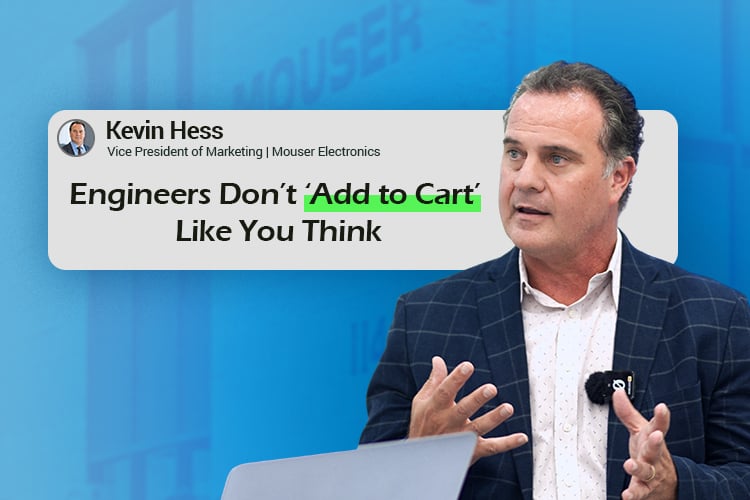
During electronica India and productronica India 2025, CircuitDigest sat down with Kevin Hess, Senior Vice President of Marketing at Mouser. The discussion covered his 35-year career at Mouser, shifts in electronics marketing, and the company’s outlook for India. The veteran reflected on the days of catalog-based sales and how he witnessed it transform into the current digital era. “The biggest change in the industry was the internet coming around, because what the internet did is, it opened up our business to everybody around the world, and you're able to get information on the web within seconds instead of within weeks of printing the catalog,” he said.
Table of Contents
When the Internet Rewrote the Rules
Marketing has moved from once printing an advert and hoping for the best to putting something on the web and being able to measure its effectiveness. Engineers used to rely on mailed line cards to order components. Each catalog update could easily take months, and the customers used to flip through printed pages and later call, send a letter, or fax the company to place an order. As time progressed, the web replaced the catalog, and the entire supply chain changed for good. Hess pointed out how the internet is what turned Mouser into a leading global player from the US-focused supplier that it once was. The speed of information, to a great extent, redefined what “service” meant for engineers, turning what used to take weeks into a matter of seconds.
Scrolling Engineers
In his view, while email and online advertising remain strong, social media is where marketing is headed as platforms like LinkedIn, YouTube, and Instagram play a central role in reaching the emerging generation. “Boy, social media is playing a much bigger picture within our industry nowadays, as these younger generation engineers are coming out of college. They really don't go to the traditional methods” he explained. Connecting with the varied engineering population requires adapting to both the audience and the platform.
Mouser manages campaigns across nearly 20 different digital platforms globally, making sure that every piece of content fits its environment. An in-depth product video that performs well on YouTube might not get the same reception on another platform. It is distinct from the short-format video that the Instagram crowd expects or a professional case study piece that would work on LinkedIn. “What you use on Instagram isn’t what you use on LinkedIn,” said Hess. “The future of social media has to be: learn how to engage with the engineer on whatever platform they’re using, and be able to engage with them and give them valuable information.”
Short Videos, Big Impact
For Mouser’s marketing team, the dominance asserted by social media platforms means leaning heavily into video content. Engineers of today prefer short and engaging videos that explain concepts quickly. Hess explained, “I think moving forward, video is going to be very important. It has to be. You're going to have your video that may be 'Open the box, let's get this up and running,' that may be a few minutes long, to your 30-second video that: 'Here's what it is, here's what you can learn about it,' and then they're on to the next video.” He also made clear how format and tone also extend to segmentation and stated, “I don't think you can develop the same thing for two types of audiences.” The messaging style intended for a senior R&D engineer is unlikely to resonate with a student experimenting with their first dev board.
Checkout? Not Yet
While discussing the unique buying habits of engineers, he brought attention to how consumer purchases and sourcing electronic components are different from each other. He drew a contrast between them by explaining how a person goes about buying a consumer good like a shoe. You come across an ad for a shoe you like, and the next step is as simple as checking the size and buying it. The journey is a bit more sophisticated for an engineer sourcing components as they typically build bills of materials over weeks or even months before checking out. They spend hours comparing parts, reading datasheets, and consulting design notes. This is the reason why Mouser does not send out reminder notifications to customers, letting them know that there are items in their cart. “There's nothing we do in that process to say, ‘Hey, you have parts in your cart; you want to check out,’ because we understand that the engineer is getting the parts for their bill of materials for their design, and they will finish when they're ready.” Value is placed on providing accurate information and tools that let engineers work at their own pace.
From BOMs to Boards
Mouser launches between 3,500 and 4,000 new products annually. Hess highlighted, “These aren’t extensions of series. These are new products, and you know, we have 1,200 manufacturing brands on our line card, and some manufacturers will have 70 new products a year. And the good thing about us is we invest in inventory. We have it on the shelf, so for marketing, an engineer can have it in their hand the very next day.” The company’s most popular tool is its BOM tool, which lets users upload a list of parts and instantly fetch pricing, lead times, and stock levels, and proceed with their purchase. Beyond procurement tools, their microsites see a lot of engineer interaction and serve as a gateway to datasheets, helping decide whether a certain component fits the needs of a project.
Engineers Marketing to Engineers
Behind the smooth customer experience is a team of marketers who understand engineering inside out. The development of a campaign involves engineers on staff collaborating with content teams to ensure technical accuracy and actual appeal. This mix of technical expertise and marketing insight is one of the reasons why Mouser remains trusted among professionals and students. “We have engineers that market to engineers,” said Hess. "Now, what role does an engineer play in how the marketing is developed? They will actually say, 'Here's the words you want to use for this product to go after an engineer or go after a buyer for these applications.' So it's very strategic on the words we use, on our ad, on who we're targeting, and what application we're going after."
Going Global, Thinking Local
Talking technology verticals, Hess said IoT and automation remain the strongest trends, with EVs showing regional variation. While he could see that AI is reshaping workflows and processes, he maintained that it is not yet a major driver of component sales. He stressed that Mouser’s global presence is built on local understanding. While he oversees marketing worldwide, local teams who understand a specific region largely dictate the company’s marketing strategy.“I think it would be stupid to think I would understand all of the different regions,” he acknowledged. “I hire people smarter than I am.”
Looking forward, he underscored the importance of India in Mouser’s global strategy. “In the next five to ten years, India will be bigger than China when it comes to the electronic component industry,” he predicted. “We are investing with people in India. We are investing in resources in India. We see India as a huge opportunity, and as a company, I would say the word is we are investing in this country."
The New Rules of Electronics Marketing
Engineers today get to access information instantly and engage with content tailored to their level of experience. Mouser’s marketing has evolved to meet this reality. Marketing content is crafted to fit both the platform and the audience. Social media plays a bigger role than anything else in reaching the upcoming engineers of today. The company not sending reminder notifications nudging customers to proceed with their carts emphasizes the importance of understanding the customer as much as the product. Global campaigns balance the company’s global strategy with local insight. The company’s evolution demonstrates how technical expertise, audience understanding, and digital transformation all combine and work together to meet the needs of modern engineers.
Though the age-old ‘five-year outlook’ question never came up, Hess fortunately tackled it for the readers:
“Somebody asked me, where do you see Mouser in five years? I will say it's wherever the design engineer needs us to be.”

